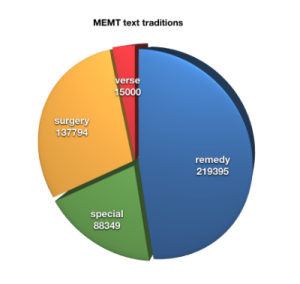Structure of MEMT
Extract from MEMT Introduction on MEMT CD-ROM (Irma Taavitsainen, Päivi Pahta and Martti Mäkinen)
MEMT contains about half a million words of running text of edited medical treatises and early printed books from different traditions of writing. We have aimed at as comprehensive a presentation of the underlying reality as possible. The top level of writings is represented by theoretical treatises transmitting specialized knowledge through learned surgical and anatomical texts. At the other end, we have simple recipes for practical use and medical sections of miscellaneous collections of household literature. The time limits of MEMT have been selected for compatibility with the research tools of Middle English (see below). The length of texts in the corpus varies. Short texts are primarily included in toto, but for copyright reasons many longer texts are represented by extracts.

The structure of the corpus is depicted by a corpus tree with its main branches according to the traditions of writing. The branch headings are in accordance with the generally accepted division, but with individual texts the affiliations are often problematic and our placings should be taken as indicative. In several cases inherent features of medieval texts, such as generic overlaps, shared sources and intertextuality, make groupings difficult and often the categories do not apply to all parts of the same text, e.g. the versatile nature of remedybooks shows in the overlaps of texts included in MEMT, and generic mixtures and blends are typical. The justification of our classification is what best suits the text extracts chosen for the corpus, even if the full text includes components that show an affiliation with another branch. In these cases our decisions have been made according to the background literature and our own knowledge of the texts. For example, the Compendium medicinae by Gilbertus Anglicus stems from learned writing but is a problematic text containing both theoretical sections and recipes; in MEMT one part of it is grouped with remedybooks according to the content of the extract, and another part is given with specialized texts for the same reason. Verse texts are recorded as a separate group and range from encyclopaedic presentations to practical advice and recipes. We have also included an Appendix of multilingual texts from about fifty years before the vernacularization processes started on a larger scale. The catalogue of texts gives essential details about the texts; users of MEMT are referred to further literature for more information. The MEMT Presenter allows other groupings as well, and scholars can access MEMT texts with other software if they so wish.
|

